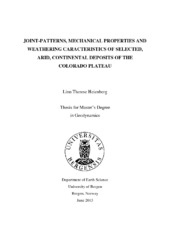| dc.description.abstract | The Colorado Plateau contains a stratigraphic sequence spanning from Precambrian to Tertiary in age, including a thick succession of Permian and Mesozoic strata that are well displayed in outcrops throughout southeastern Utah, USA. The appearances of these units, which are controlled by their weathering history, are all unique and pose the question: Why should units with similar depositional environment and burial history look so different?" The most pronounced differences involve their erosional slopes, surface morphology, color and degree of fracturing. There are a number of possible factors that can contribute to the differences in weathering patterns: (1) depositional environment (2) different degree of lamination/stratification and thickness of bed units (3) different mineralogy and grain size/sorting (4) different degree of lithification/cementation and (5) different types of cement. Following in this thesis is a study of the erosional slopes, sedimentological- and mechanical properties and fracture-patterns of these seven stratigraphic units (listed in stratigraphic order from bottom to top with their average slope values in the brackets): the Cutler Formation (30- 35°), the Chinle Formation (28-33°), the Wingate Sandstone (77-82°), the Kayenta Formation (65-70°), the Navajo Sandstone (43- 48°), the Slick Rock Member (50-55°) and the Moab Member (78-83°). These formations also show different fracture-frequency distributions, which again relate to their mechanical properties and different degree of cementation. The joints in the study area post- date the deformation bands and faults and were most likely formed during the Tertiary uplift and exhumation of the Colorado Plateau. Both naturally occurring fractures in addition to fractures formed by hydraulic fracturing are essential for economic production of hydrocarbons in sandstone reservoirs. In this paper both sedimentological and mechanical properties have been investigated and analyzed in an attempt to explain the different appearances of these sandstone units. | en_US |
